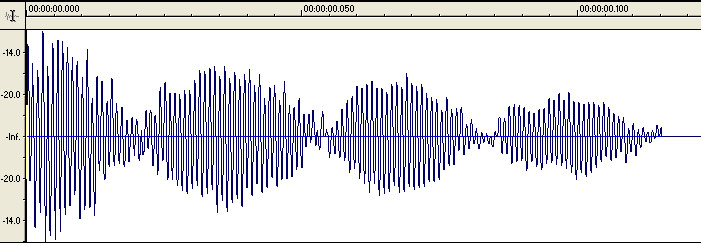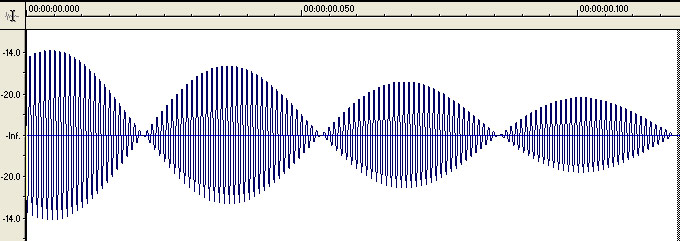Identifying and Tuning Lateral and Torsional Modes in Marimba bars
Part Three - Tuning the Modes
Jeff La Favre
(jlafavre@gmail.com)
|
Description of some methods used in the study Part One - Establishing Tuning Standards (36 images, 1.17 MB total) Part Two - Identifying and Measuring the Modes (38 images, 1.8 MB total) Part Four - Lateral and Torsional Modes for Bars D4 through C7
Retuning the First Lateral Mode of the A2 barThe work in this section deals in more depth with the problematic first lateral mode of the A2 bar and how it was retuned. As time permits, more bars of the La Favre marimba will be retuned and the results reported here. The A2 wave trace for the first 0.2 second is illustrated below. Notice that during the first 100 milliseconds of vibration (1/10 second), there is a strong beating pattern. This is the result of the mixing of the two frequencies (1090 Hz and 1121 Hz). The resonators were removed from the marimba for this test to keep the fundamental low. Therefore, the sound linked below does not match the typical sound for an A2 bar with resonator in place. Use the link below to hear the bar vibrate.
|
|
The most problematic zone of vibration for this bar is approximately 0 to 115 milliseconds. The wave trace of this part is provided in the illustration below. Listen to this part of the vibration cycle for the A2 bar by using the link below the illustration.
The illustration below is a wave trace for a computer-synthesized sound, created by mixing two pure tones (1090 Hz and 1121 Hz). Notice that the synthetic sound has a beating pattern similar to the wave trace of the A2 bar. Listen to the synthesized sound by using the link below the illustration. While the recording of the A2 bar sounds much different than the synthetic sound, try to hear the synthetic element in the A2 bar.
The sounds are not the same because the A2 bar has additional frequencies. If we examine the spectrum carefully, there are some minor peaks at 112, 315, 412, 445 and 716 Hz. So we will add those frequencies to see if we can come closer to the real A2 bar.
Now the synthetic sound is much closer to the real A2 bar. In order to assist in comparing the synthetic sound to the A2 bar, the sounds were incorporated into one audio file. The first 120 milliseconds of the A2 bar is heard first, then the synthetic sound. Use the link below the wave trace illustration to compare the two sounds.
The beating sound caused by the mixing of the 1090 Hz and 1121 Hz frequencies results in a complex tone that is less desirable than the 1121 Hz frequency alone. Keep in mind that the 1121 Hz frequency of the third transverse mode is only one component of the timbre of the A2 bar. The synthetic sound of the 1090 Hz and 1121 Hz mixture is compared to a synthetic sound of just the 1121 Hz frequency in the wave trace illustration below. Use the link below the illustration to listen to the sounds.
In order to eliminate the beating problem in this bar, the first lateral mode must be retuned so that it vibrates at a frequency farther from or closer to the third transverse mode. First I tried to improve the tuning by reducing the bar width by 1/32 inch. This did not improve the tuning. Then I tried wedging as a tuning method for the first lateral mode and this did improve the tuning. Retuning the barThe salt method was used to examine the bar vibration patterns at different frequencies. When the bar was exposed to tones of 1090 Hz and 1121 Hz, it vibrated with enough intensity to clear salt from the most active area of vibration (the area in the vicinity of the antinode). The photo below shows the pattern of salt on the bar after excitation at 1090 Hz. Note that the salt cleared from a semicircular area in the center of the bar length. Also note that the semicircular area is positioned more toward one side of the bar.
The photo below shows the pattern of salt on the bar after excitation at 1121 Hz. Here again there is a semicircular area at the bar center, but in this case on the opposite side of the bar.
From these results it was concluded that the center of the bar vibrates at 1090 Hz on one side and 1121 Hz on the other when struck with a mallet. These results were not anticipated. It was expected that excitation at 1090 Hz would result in a salt pattern indicative of the second torsional mode. However, later in this investigation the second torsional mode was found to vibrate at 880 Hz. When holding the bar in the proper position for determining the third transverse mode, the strobe tuner indicated a frequency of 1121 Hz when the bar was struck in the center. When the bar was held near the end of the arch (damping the third transverse mode) and struck near the bar edge on the 1090 Hz side, the strobe tuner also indicated a frequency of 1090 Hz. And when struck on the other side of the bar, the strobe tuner indicated a frequency of 1121 Hz. Since the initial thought was that the 1090 Hz frequency was due to the second torsional mode, 1/32 inch was removed from the bar width in the hope that the errant mode would be improved. The tuning was not improved. Then wedging was applied to the bar, which did improve the tuning. The photo below shows the bar after retuning. Wood was removed along the bottom sides of the bar and the bar ends were chamfered as required to keep the transverse modes from dropping below the target frequencies. The bar was checked with the strobe tuner frequently during the removal of wood, which helped to identify the areas of the arch where wood should be removed to achieve the desired tuning.
Photo below shows the chamfering on the bar end (both ends were chamfered). During the wedging process, the fundamental and second transverse modes were lowered below their target points. By removing wood from the bottom side of the bar ends, the frequencies of the fundamental and second transverse modes were raised so that all modes could be tuned to the proper frequencies.
FFT spectrum of retuned A2 bar struck in the center, no resonator in place - sample time 0 - 186 ms. After retuning, the bar vibrated at 1108 Hz and 1124 Hz. Recall that our tuning standard for frequencies between 1000 and 2000 Hz requires a difference of 15 Hz or less. The difference here is 16 Hz, so close enough. The retuning was successful. For comparative purposes, the original wave trace of the A2 bar is provided below.
|

The illustration below is the wave trace after retuning. It is evident that the beating rate is reduced and muted.

|
The first 120 milliseconds of the A2 vibration prior to retuning and the first 120 milliseconds after retuning were incorporated into one audio file to allow comparison of the two sounds. The retuned sound comes after the original, as is evident in the wave trace below. Use the link below the wave trace to listen to the sounds.
I used a Fostex model MR-8 with Shure dynamic microphone model SM57 to record the audio of bars and used Sound Forge software to display the wave traces. You can do wave trace analysis of your own marimba bars if you have access to a computer. All you need is an inexpensive microphone for your computer and some free audio recording software that you can download from the Internet. I recommend Audacity (unless you want to purchase Sound Forge or similar), which is available at http://audacity.sourceforge.net/. I tested an inexpensive microphone with my computer and got acceptable results. While the inexpensive microphone plus computer setup had less sensitivity than the Fostex plus Shure microphone, I could still easily analyze the wave traces. Continue to Part Four - Lateral and Torsional Modes for Bars D4 through C7 Description of some methods used in the study Part One - Establishing Tuning Standards (36 images, 1.17 MB total) Part Two - Identifying and Measuring the Modes (38 images, 1.8 MB total)
Last update: 3/24/07 © 2007 Jeffrey La Favre
|










